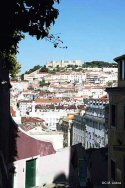 |
|
Lisbon is built on hills looking out over the River Tagus and is
one of Europe's great cities. Modern and cosmopolitan, it is a great
centre of culture and tourism.
Fado centres
In Bairro Alto, full of the history of 'fado', the nights are one big party,
where you can have a drink or an espresso amid the bustle. The alleys, steps and
side streets in Mouraria and the murmurs of the melancholy nights have moulded
the feeling of 'fado', in which many listeners find the ancestral pulse of
Africa and the Arab world. Meanwhile, grilled sardines and peppers form the
aroma of Alfama in the commotion of the saint's day festivities in the summer.
Old districts
In the chessboard layout of the Baixa and Chiado districts, there are routes
seemingly used by half of Lisbon. In the 19th century Lapa district are elegant
palaces, while in Alcântara, the home of the working classes, we still find the
old, traditional way of life.
Cultural centres
Chiado is located on one of the city's hills and evokes the bourgeois charm of
the 19th century when it developed. Together with Bairro Alto, it is one of the
city's cultural and social centres, and houses many bookshops. The antique shops
are concentrated mainly in Campo de Santa Clara, Rua de S. Bento, Rua do
Alecrim, Rua de D. Pedro V and further along in Rua da Escola Politécnica. There
are countless historical cafés and restaurants in Pombal's Baixa area and
Chiado, such as the Café Nicola, Martinho da Arcada, Tavares and A Brasileira do
Chiado.
Parks and palaces
There are also many museums, churches, monasteries and palaces, as well as fine
parks, such as Parque Eduardo VII, the botanical gardens in Ajuda, Príncipe Real
and Belém. There are also gardens in Estrela and Parque do Monteiro-Mor, among
others. Bars, clubs and restaurants have invaded Avenida 24 de Julho, Alcântara
and Bairro Alto, and the Docas area in the docks, where the nights are wild.
These and a wealth of other attractions make Lisboa such a pleasant and
hospitable city.
|
| | Praça do Comércio |
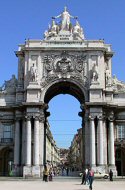 |
|
It's easy to describe the Commerce Square, also known as Palace Square
(Terreiro do Paço), in just one word: WOW! This is one of the most majestic
squares of Lisbon and was once the main maritime entrance to Lisbon. You can
still see the old marble steps leading up to Commerce Square from the River
Tagus. The name Palace Square is clearly a reference to the Palace that was
located here for 400 years, until the 1755 earthquake that almost completely
destroyed it.
On the north side, the square is centred by an impressive 19th-century
triumphal arch that leads to Rua Augusta, one of the main pedestrian shopping
areas in downtown Lisbon. The arch is decorated with statues of historical
personalities, like Vasco da Gama (Portuguese sailor) and Marquês do Pombal
(responsible for the reconstruction of Lisbon after the earthquake).
The spacious arcaded buildings extended around three sides of the square are
now occupied by government administrative offices and some restaurants.
Talking about restaurants, this is also the place where Lisbon's oldest café
stands: "Martinho da Arcada" opened its doors with oil burning lamps, it was
later given gas illumination and then much later gained a different glow with
the installation of electricity. "Martinho da Arcada" saw the big revolutions of
the last two centuries and took in clients like Bocage, Fernando Pessoa and
Amália.
At the centre of the Commerce Square, once used has a car-park and now given
back to the Lisboetas (people from Lisbon), stands the equestrian statue of King
José I, King of Portugal during the earthquake in 1755. The dark bronze horse,
depicted trampling on serpents, is often called "Black Horse Square" by the
English. The locals do not particularly care about the horse... but who is
sitting on it!
|
| | Castelo de São Jorge |
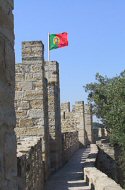 |
|
Saint George Castle is a magical place, a charming hilltop citadel with geese
and ducks roaming around the castle gardens. Once used as a fortress, today it
is home to many local families and a place that certainly deserves a visit.
Visitors can climb the towers and walk along the reconstructed ramparts of the
castle walls and wonder at the spectacular views over Lisbon and the Tagus
river, while local men play backgammon and cards under the trees.
Conquered by the Moors in 1147, Saint George Castle has an area of around 6000
square metres with several towers, look-outs, a dry moat and two squares divided
by an internal wall with a connecting door.
Also not to be missed on this castle is the Ogival House, with its five ogival
arches, where you can see the 17th-century door that made the connection to the
jails once located here.
The symbiosis between the castle and the landscape couldn't be better. Due to
its historical background and the dazzling views it offers, this is the perfect
place for a well-spent afternoon!
|
| | Elevador da Glória |
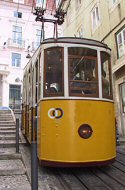 |
|
The Glória Funicular is one of the funiculars existent in Lisbon, right
downtown, most precisely on the Restauradores Square. It makes the connection
between this square and Bairro Alto (literally High Quarter) on a 265 metres
journey up or down the hill.
When you go out of the funicular you will find on the right side the S. Pedro de
Alcântara belvedere, from where you get a magnificent view of downtown Lisbon
and the magical St. George Castle. Just across the road, slightly to the right,
at Rua de S. Pedro de Alcântara, nos.39-49, lies the Instituto do Vinho do
Porto, where a vast range of port-wines may be tasted and purchased in the
sumptuous surroundings of the Palácio Ludovice (1749).
The Glória funicular opened on 24 October, 1885, and since then two funiculars
have been going up and down, carrying locals and tourists on a journey though
not being particularly rich in landscape, is still unique and very nice!
The Glória is the busiest funicular in Lisbon and also the most accessible for
tourists as it lies next door to the main tourist information office in the
Palácio Foz. It is 265 metres long and has an average gradient of 18%. Operating
hours are 0700-0055 every day.
|
| | Elevador de Santa Justa |
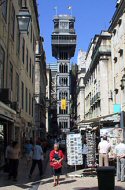 |
|
The Santa Justa Elevator is a remarkable masterpiece designed by an apprentice
of Gustave Eiffel and makes the connection between the Baixa (downtown) and
Bairro Alto (high neighbourhood).
It was opened in 1902, when it was steam powered, then in 1907 it became
electrical and was the only vertical elevator in Lisbon in public service. Made
entirely of cast iron, and embellished with filigree, the lifts within the tower
go up to 45 metres and carry 25 persons in each cabin of which there are two. In
a romantic neogothic design, this elevator is really something that you cannot
afford to miss!
The café at the top affords magnificent views over the centre of Lisbon and the
Tagus River.
|
| | Igreja do Carmo |
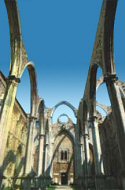 |
|
This amazing gothic monument, or what's left of it, was founded by Nuno Álvares
Pereira, the commander that became a member of the Carmelite Order. Its
construction was finished in 1423 and was at that time the biggest church in
Lisbon.
The ruins of the Carmo Church, left by the devastating earthquake in 1755, are
best seen from the Baixa (downtown) especially from Rossio, from Graça or from
St. George Castle. They represent centuries of history and is home to the
Archaeological Carmo Museum.
In this museum there is a historical collection of inestimable value with pieces
from prehistory to contemporaneity. So, make sure you go beyond the external
wealth of these ruins and take a look inside for an enriching insight into the
past!
|
| | Eduardo VII Park |
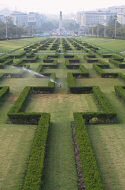 |
|
Eduardo VII Park is located on the extreme north side of the Liberty Avenue,
right behind the Pombal Marquis Square, and was originally called Liberty Park.
Renamed with the name of the King of England who came to Lisbon in 1903 to
reaffirm the Anglo-Portuguese alliance, this park provides excellent views over
the city and is frequently used to hold exhibitions, concerts and the annual
booksellers fair.
Within the park you can find the Sports Pavilion, built in 1932, nowadays named
'Carlos Lopes Pavilion' as a tribute to the Portuguese athlete of the same name,
some lakes, statues, an amazing sculpture made by João Cutileiro in a reference
to the 25th of April Revolution, Clube VII with tennis court, gym, swimming pool
and restaurant.
And the Oscar goes to... (can you hear the drums?)... the Cold Greenhouse! This
is a real green museum where plants and flowers from the five continents grow
harmoniously together under a huge planked roof that beautifully regulates the
air temperature and the intensity of light. It was built in 1930 and allows
visitors to rest their spirit and purify their senses in front of an enchanted
scenery of lakes, fountains and statues.
The area is divided in three different zones: the original greenhouse, the hot
greenhouse and the sweet greenhouse. Within the first (also the coolest) you'll
find an extraordinary vegetation that benefits from the construction (iron and
strips of wood); the hot greenhouse, covered with glass, displays species that
need a hotter atmosphere to survive; and the sweet greenhouse is the territory
of several species of cactus... watch your feet!
|
| | Praça Marquês de Pombal |
 |
|
This square is a challenge for any driver. If you don't have much experience as
a driver, after passing through the roundabout of the Pombal Marquis Square you
will feel ready for almost anything!
The Pombal Marquis Square is located between the Liberty Avenue and Eduardo VII
garden. In the centre of this square rises the splendid monument to Pombal, the
man who was in charge of Lisbon's reconstruction after the 1755 earthquake. On
this monument, the marquis stands on top of the column with his hand on a
lion(symbol of power) overlooking his masterpiece: downtown Lisbon.
Directly connected to his life, this monument counts on references to Pombal's
reforms in education, politics and agriculture and to the moment that changed
his life - again the 1755 earthquake, represented by broken blocks of stone and
tidal waves flooding into the city.
|
| | Avenida da Liberdade |
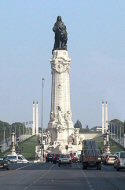 |
|
Shops, hotels, some of the best coffee shops, esplanades, theatres,
universities... You will find everything here and more! This is the Avenue of
Liberty, synonimous with elegance, fashion and motion ... like a living vein
that makes the connection between Pombal Marquis Square and downtown Lisbon.
This is one of the most (if not the most) important avenues in Lisbon and is
also the central point for offices, centenary trees, international fashion shops
and thousands of "passing-through" workers.
Being a good place for a walk, make sure you take a look at the ancient tailor
shops, followed by internationally-known brands like Calvin Klein, Timberland,
Massimo Dutti, Armani, Burberrys and Adolfo Dominguez. Walking the Liberty
Avenue was once a social custom synonimous of elegance and today still is!
If you feel tired, just sit at one of the local esplanades with the traditional
white wrought iron chairs and have a drink, whilst you take a moment to
appreciate the amazing work the Portuguese paviours have done in this area.
|
| | Praça dos Restauradores |
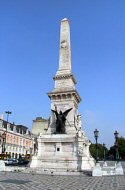 |
|
The Praça dos Restauradores (Restorer's Square) is located on the south end of
Avenida da Liberdade (Liberty Avenue), right beside the Rossio railway station
(also an architectural masterpiece not to be missed!). This is a busy area of
Lisbon and also the place to find the recently renovated Orion Eden, once a
theatre and today a hotel that has kept the wonderful original façade.
Easily recognisable because of its Obelisk and the sculpture that commemorates
the 1640 restoration of Portugal's Independence from Spain, this square has much
to see, but the best is the architecture that can be seen in the surrounding
buildings, like Palácio Foz, Orion Eden Hotel, the small bandstand, Avenida
Palace Hotel, and many others.
Close by you can find the Elevador da Glória (Glória Funicular) that will take
you to the charming area of Bairro Alto.
|
| | Praça da Figueira |
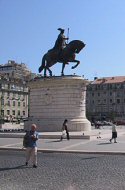 |
|
"There is a period of popular celebrations when the Alfacinha (person from
Lisbon) doesn't leave the city and when a certain 'power of the peasants' falls
into Lisbon. It is in June when the celebrations of Santo António, São João and
São Pedro take place. Nights at Praça da Figueira and surrounding areas have a
special province stamp in the contagious joy of descants, guitars, coloured
balloons, clay pipes, fruit sellers, basil and carnations, all that coming and
going of groups impeled by fun, without nexus and meaning, human formicary, mob
wave".
Alfredo Mesquita.
This was a description of Praça da Figueira (Figtree Square) made in the 19th
century. At this time Figtree square was the centre of popular saints
festivities and during the day it was used as the city's central marketplace.
Nowadays, the reality of this square is a lot different: the open market gave
way to shops, hotels and cafés and a bronze statue of King João I stands on a
pedestal right in the middle of the square. Hard to miss are the hundreds of
pigeons that perch near the pedestal.
Figtree square is also a busy transit point, located directly between Rossio and
Martim Moniz, sporting all kinds of transportation, such as the Metro and buses
to the charming trams, that will take you almost anywhere in the city.
|
| | Rua Augusta |
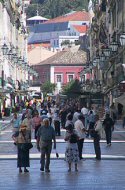 |
|
Rua Augusta (Augusta street) is located in one of the busiest quarters of
Lisbon. Closed to traffic, this pedestrianised street has all sorts of shops for
all sorts of tastes, flower peddlars, hot chestnuts sellers, street cafés,
independent street Artists like the "statue man" or the familiar harmonica
player and many, many more.
This street has on both extremes two magnificent squares: the Rossio Square and
the Commerce Square. Near the arch that gives way to the Commerce Street you
will find many peddlers with all sorts of things to sell from jewellery to shoes
to handbags, neck-scarfs to temporary tattoos... anything... just name it!
Another curious thing in this area is the name of the streets that run parallel
to Rua Augusta. They all come from the occupations or the materials once
existent and worked on here: Rua dos Sapateiros (shoemakers), Rua da Prata
(silver), Rua do Ouro (gold), etc.
The old architectural style, originally from the reconstruction of Lisbon made
by Marquês do Pombal after the 1755 earthquake, is still intact, so you can see
many of the buildings as they originally were. You're going to love this street!
|
| | Rossio |
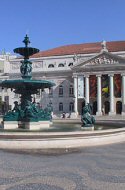 |
|
Rossio is one of the most beautiful squares in Lisbon. People pass here
everyday, rushing for work, and hardly take the time to look around. It's not
only the beautiful monuments and the fountains, or its fascinating history...
Rossio is a living book.
Recently renovated, it hasn't lost any of its mysticism... Feel it around the D.
Maria II National Theatre, where many plays were, and are, performed and seen by
Kings and Queens, around the fountains used at the beginning of October to
baptize the freshmen as they were about to enter the University -, around the
cafes frequented by famous Portuguese personalities - like Cafe Nicola founded
in 1929 - and yes, oh yes, smell it on freshly roasted chestnuts that have been
sold in the Rossio Square for many many years.
In the middle of the square there's a statue of Dom Pedro IV and at its foot the
four female figures representing Justice, Wisdom, Strength and Moderation,
qualities attributed to Dom Pedro himself.
The originally called 'Dom Pedro IV Square', got the name Rossio from the local
people and it's still today a traditional meeting point both for Lisboetas and
visitors.
|
| | Rossio Station |
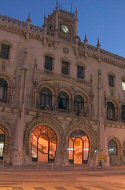 |
|
In neo-manueline style, the Rossio railway station is an outstanding building
set between Rossio Square and Restauradores Square and was designed by the
architect José Luís Monteiro. The eight doors match the nine palatial windows
and the incredibly decorated clock tower located on the top of the facade.
Rossio station is a curiosity in that the platforms are some 30 metres above the
main entrance. Services from here are all suburban trains to the tourist sights
of Sintra via Queluz.
Built in 1886/87, this station has been recently renovated. The boarding
platform is now connected to the Metro Station, though this is with the nearest
Metro station at Restauradores, (not with Rossio Metro) and the work done on the
ceiling is simply breathtaking. Make sure you pay a visit to the Rossio Station,
I'm sure you'll find it worth it.
|
| | Chiado |
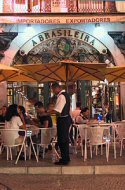 |
|
Chiado is nowadays a noble shopping area with all sorts of facilities and street
entertainment. Here you will find hotels, theatres, bookshops, museums,
restaurants, famous Portuguese fashion houses and the famous haunt of
personalities like Fernando Pessoa and Eça de Queiroz, in a location actually
chosen by the city's art students: the café "A Brasileira".
This area has that 'special something' and you can see it in the buildings and
live it in the story of the 1988 fire.
On the 25th of August 1988, Chiado was devastated by a fire that started in a
store in Carmo Street and that spread to Garrett Street. Even though there are
still some scars of that disaster, a massive renovation programme has brought
todays Chiado back to life and it is better than ever!
|
| | Sé Catedral |
 |
|
The Cathedral is the most important religious building in Lisbon. It is a
fortified church built in a late Romanesque style showing various styles since
rebuilding: Gothic (the chapels of the body of the church, the ambulatory and
the cloister), Renaissance, Mannerist, Baroque (the chancel, the sacristy,
treasury, the chapel of the Blessed Sacrament). The façade and the body of the
church are structurally Romanesque. A galilee porch preceding the portico of
four archivolts, flanked by two towers, composes the façade. A rose window is
placed over the Galilee porch. In the cloister there are archaeological remains
of the Roman and Arab occupation periods.
|
| | Miradouro de São Pedro de Alcântara |
 |
|
This belvedere, or 'miradouro' in Portuguese, is located at the top end of
Gloria's funicular route, close to one of the many entrances to Bairro Alto.
From here you will be able to see magnificent views of Lisbon, especially of St.
George's Castle and the Graça area. This wonderful vantage point will give you a
unique insight into the city that has successfully merged the old and the new.
Quiet during the day, this belvedere completely changes at night. Old men
playing cards or just walking their four legged friends give way to the young
crowd that seek fun and action found at night in the Bairro Alto.
|
| | Alfama |
 |
|
Visiting Alfama is to visit the architecture, the sounds and the smells of old
Lisbon. This is one of the most typical quarters of Lisbon. On its narrow and
winding streets you'll find the hidden treasure of Alfama and on its steep
stairs you will be able to breathe the soul of Lisbon.
In Alfama, it is still possible to see Roman and Arab remains, two of the most
dominant civilizations in Lisbon's past. There are narrow streets resulting from
Muslim culture, guided by individualistic rules where public spaces are not
important. The narrow streets are a mark of the Coran, where little value is
given to facades but a much greater value is given to the interiors of the
houses.
Alfama was once home to the unlucky, delinquents or non-grateful and due to its
proximity with the river it was also the home of many sailors.
Rebuilt by the local population after the 1755 earthquake, Alfama was to be
demolished but the decision didn't go through as this region of Lisbon was
thankfully considered to be a living history book where the past blends with the
present.
|
| | Palácio de Belém |
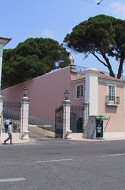 |
|
It's a shame that tourists have no access to Belém Palace, but even from outside
this is still something you shouldn't miss. This is the official residence of
the President and was built in 1559 by the noble D. Manuel de Portugal and is
located in an area that you will definitively, surely not want to miss. In the
18th century this palace was called 'palace of the lions' and its badge seems to
be the lion - solar symbol that combines Wisdom and Power - that can be seen in
several locations around the palace.
The entrance to this Palace is watched over by two guards. It's amazing how
serious they look (I remember when I was just a child. I used to stand in front
of them trying to make them smile, laugh or just look at me, but they never did!
Well, at least I tried). The guards use a magnificent uniform, a curious helmet
with a white tail and a sword that is hung on their belt... It makes you think
you've gone back in time.
|
| | Mosteiro dos Jerónimos |
 |
|
The Jerónimos Monastery is usually referred to as the “jewel” of the Manueline
style. This exclusive Portuguese style combines architectural elements from the
Gothic and from the Renaissance periods, joining them with a royal and
naturalist symbology, that makes it unique and honourable.
In 1496, King D. Manuel I asked the Holy Sé for permission to build a large
monastery on the banks of the river Tagus. The works started in 1501 and almost
a century later everything was done. D. Manuel I and his descendants were buried
in marble tombs located in the chancel of the church and in the transept lateral
chapels.
Dedicating the monastery to the Belém Virgin was another factor that influenced
the royal decision. The Jerónimos Monastery replaced the church of Saint Mary of
Belém where monks of the Christ Order gave assistance to sailors passing
through. For this reason, D. Manuel I chose the monks of the Saint Jerónimo
Order whose functions were to pray for the soul of the king and give spiritual
assistance to the sailors that left Praia do Restelo in discovery of new lands.
Because the monastery was built on the sand banks of the river Tagus, the great
earthquake of 1755 had little effect on the structure.
In 1907 it was declared a National Monument and in 1984 it was classified
“Cultural Heritage of all Humanity” by UNESCO.
There remains a lot to be said about this monument, but I leave you with one
final word... AMAZING!
|
| | Monument to the Discoveries |
 |
|
The Monument to the Discoveries was inaugurated in 1960 during celebrations of
the 500 year anniversary of the death of the Infant D. Henrique (Henry the
Navigator). It evoques the maritime expansion and is designed in the shape of a
caravel, showing Henry the Navigator at the prow holding a small caravel, as
well as many relevant heroes of Portuguese history (Vasco da Gama, Pedro Álvares
Cabral - discoverer of Brazil - Fernão Magalhães - who crossed the Pacific
in1520 -, the writer Camões and many others).
Seen from the huge mariners compass this monument fascinates visitors with its
impressiveness and its 50 metres height. It is visited by millions of people
each year. Cut into the paving stone, the compass (see panel above) was a
present from the Republic of South Africa in 1960 and it's best seen from the
top of the Monument to the Discoveries, that you can access by elevator located
inside the building. The central map, depicting galleons and mermaids, shows the
routes of the discoverers in the 15th and 16th centuries.
It is located in Belém, on the bank of the River Tagus, in an unique monumental
area and looks particularly dramatic in the light of the late afternoon sun.
|
| | Torre de Belém |
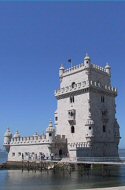 |
|
Belém Tower was built in the Age of the Discoveries (when defending the city was
of paramont importance) in tribute to the patron saint of the city, Saint
Vicente.
In order to enhance Lisbon’s defence, King João II drew up a plan that consisted
of forming a three-fortress-defence on the Tagus’s estuary. It formed a triangle
and on each angle, a fortress was constructed: Cascais's fortress on the right
bank, S. Sebastião da Caparica on the left bank and Belém Tower in the water.
The tower is replete with Manueline decoration, symbols of the King’s power:
cables encircling the building and terminating in elegant knots, armillary
spheres, crosses of the Military Order of Christ and naturalistic elements such
as the rhinoceros, the first such representation in stone known in Europe.
In time, with the construction of new, more modern and more effective defences,
the Tower of Belém lost its role as defender of the entrance of the River Tagus.
As centuries passed, new functions were given to the tower. It was a customs
control point, a telegraph station and even a lighthouse.
It also served as a political prison, its storerooms transformed into dungeons,
since the time when Philip II of Spain became king of Portugal (1580) and during
periods of political unrest. Finally, in 1983 UNESCO classified it as a World
Heritage Site.
|
| | Planetário Calouste Gulbenkian |
 |
|
Man has already launched many satellites, walked in space and on the moon and
sent space probes to the remotest parts of the solar system. But, apart from all
these technological and scientific advances, we still have little knowledge
about the moon... the sun... the stars... and about our own planet! Here is a
chance to get to know them better. Just sit back and relax - as the heavens open
up and reveal themselves to you
The Planetarium is located in Belém, right beside the Jerónimos Monastery and
near the Cultural Centre of Belém and the tasty, original Pastéis de Belém
(cream tarts) Factory.
The Planetarium recreates the sky at night and reveals the mysteries of the
cosmos. The several sessions, presented in Portuguese, English and French, will
tell you more about 'The solar system', 'The moon', 'The evolution of the stars,
'The movement of the earth', ' Earth - Planet Alive', 'The universe', 'The sun',
'The constellations' and many others.
|
| | Tarts of Belém (Pastéis de Belém) |
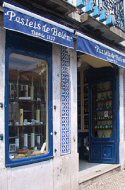 |
|
Passing through Belém?... For your own sake, try one, or two, or three, or
four... sorry, I always get carried away when it comes to eating one of these
tarts... Anyway, as I was saying, make sure you try at least one of the famous
Belém custard tarts from the original factory, located in the beautiful area of
Belém.
Every morning, the 'tarts master' works in the kitchen using a recipe unique
throughout the whole world. Apart from putting together the right portions of
the right ingredients, the art of producing these Portuguese tarts lives on in
making them in the old fashioned way - no machines are involved here, just
careful and talented hands!
As many of the sweets belonging to the Portuguese gastronomy, the tarts have
their origin in conventional roots. According to the story, there was a
confectioner, the owner of a sugar refinery - Domingos Rafael Alves - who became
the friend of a pastryman that worked in the Jerónimos Monastery. With the
revolution of 1820 many religious orders were discontinued, leaving monks and
nuns homeless and workers unemployed.
That was when the confectioner hired the pastryman - holder of the secret recipe
of the tarts, the man that started the confectioners shop and the one and only
Belém custard tarts factory!
Meanwhile, behind the facades of the refinery, the pastryman worked until dawn
and later the owner registered the patent of the recipe, keeping it secret until
today. Nowadays, the factory produces around 14 thousand tarts a day and you
must be wondering if they can sell them all? If you still have doubts the best
way is to try one... if only one will satisfy your curiosity...
As the factory produced more tarts, the need for more workers became a serious
concern. The possibility of having the secret recipe leak out was something that
couldn't happen, so the new pastrymen could only be chosen from inside the
company - in this case they must have been working for the factory for at least
25 years, someone who the company could trust. Even then, they had to make a
oath and sign an agreement where it said they couldn't reveal the secret of the
tarts. If they broke this contract their properties would be expropriated and
they could even go to jail. Fortunately, no one ever broke it and the secret
still remains inside the factory walls today.
You can eat custard tarts in many cafes, but none would taste like the original
tarts, specially when they are still hot and you sprinkle them with cinnamon and
powder sugar. But, even if they're cold, they are still quite delicious
Just make sure you take some more with you. They are very well packed in special
boxes with the little packets of sugar and cinnamon and before you leave the
factory, take a look around - you'll be amazed at the tiled panels in some of
the five rooms opened to public.
|
| | Ponte 25 de Abril |
 |
|
The 25th of April Bridge, also known as Bridge over the Tagus (Ponte sobre o
Tejo), was inaugurated in 1966 with the name 'Salazar Bridge', the dictator who
had it built. It was later renamed to commemorate the 'Carnation Revolution'
that happened on the 25th of April 1974. This was a day of "bloodless
revolution." In the Carnation Revolution, the soldiers placed carnations in the
muzzles of their rifles as they led the revolt against the world's longest
dictatorship.
This suspension bridge is very similar in appearance to the Golden Gate Bridge
in San Francisco. It is 2.278km long and leaves Lisbon at high level above
Alcântara and makes landfall at Almada on the southern bank of the river.
Particularly busy during weekends, traffic jams can be avoided by taking the
recently-built Vasco da Gama bridge or leaving your car on a parking lot and
taking the train that passes on the under side of the bridge since 1999.
On the Almada side you will be able to see the towering monument of Cristo Rei,
similar to the Redentor in Brazil, overlooking the Tagus. If you wish to go
there, a lift will take you up 82m to the top of the pedestal, offering
excellent views of the city and the river.
|
| | Ponte Vasco da Gama |
 |
|
This newest bridge in Lisbon, Ponte Vasco da Gama, enables north-south traffic
to bypass the Portuguese capital and was built as an alternative route to the 25
de Abril Bridge, frequently congested with traffic jams especially during the
rush-hour periods.
This seemingly never-ending bridge is a Cable-stayed bridge. The builders took
special steps to protect a local bird sanctuary and rehoused 300 families, who
were living in slums, to much better accommodation
Vasco da Gama is the largest bridge in Europe with a length of 17.2 km (10
miles), 10 km of which are over the Tagus river. It was inaugurated on the 4th
of April 1998. Located right next to the Nations Park (former site of the Expo
98) it got its name on the same year of the 5th centenary of the arrival of
Vasco da Gama to India.
The bridge was designed to withstand an earthquake four times greater than the
1755 earthquake that devastated Lisbon.
|
| | Botanical Gardens |
 |
|
Ajuda's Botanical Garden is the oldest botanical garden in Portugal. Built in
1768 by order of the Pombal Marquis, this garden was used by the princesses of
the Ajuda Palace and was used as a gathering point for all the species that were
brought by the Portuguese discoverers from other countries.
Located in Ajuda, this garden has trees more than a century old and a wonderful
view of the Tagus river. Divided into three different areas, Ajuda's Botanical
Garden countains four hothouses, one of which being actually used as a
restaurant, three lakes, porcelain flower-pots from the 19th century, an
18th-century fountain decorated with writhing serpents, winged fish, sea horses
and mythical creatures and many plants and flowers.
The entrance, through green wrought-iron gates in a pink wall, is easy to miss.
Opened between 9 am and 8 pm.
|
| | Jardim Zoológico |
 |
|
With one of the best zoological exhibitions in the world set in enclosures very
similar to their original habitats, this garden also offers diverse leisure
activities as well as other services.
The main attractions are:
Dolphins Bay: the Dolphins Bay was begun in 1995 and is now one of the biggest
attractions of the Zoo. Don't miss a funny and interesting show that takes place
in the scenery of a fishing village! This show combines the acrobatics of the
dolphins and the sea-lions with some interesting information about the
characteristics of these animals, their adaptation to marine life and some
ecological elements. Give yourself the opportunity to come and learn in a very
amusing way!
Cable car: Opened in 1994, the cable car also became one of the biggest
attractions. In two persons cabins, visitors can enjoy a 20 minutes ride over
the Zoo offering a most unique view of the zoo gardens. Passing over the
hippopotami, the tigers, the lions and many other animals will surely leave you
breathless.
Sea-lions: In the sea-lions area you can see a daily show where the relationship
between the coach and these affable animals is quite unique. As he introduces
each sea-lion to the public, he makes them do some acrobatics and he teaches
children about the habits of these fantastic animals.
Reptile land: From the beginning of cellular life on Earth, about 4 thousand
million years ago, life was only present in the sea. Around 370 million years
ago the first vertebrate animals came to land and reptiles where the first
terrestrial animals. They dominated life for most of the periods, including the
Jurassic period, and dinosaurs reached the climax of the reptile evolution.
Since then no other species has ruled the Earth for as long as they did. Killed
by a still-unknown phenomenon, dinosaurs existence ended many, many years
ago.... but some reptile species resisted all the adversities and manages to
survive until today. Visiting reptile land in Lisbon's Zoo means going back in
time and learning all this and more.
Macaw Show: In the Little Theatre of Nature (Teatrinho da Natureza) an
ostentatious and cheerful group of macaws, cockatoos and parrots ride bicycles,
do roller-skating, drive jeeps, while others show their intellectual capacities
by making calculations and some just sit lazily on sun beds.
Little farm (Quintinha): The little farm was created in 1996 to bring people
back to the 'countryside'. Within this area the intention is to stimulate close
contact between children and domestic animals frequently seen on rural
properties and allow children to see a wide variety of vegetables and fruit in a
natural environment.
|
| | Palácio de São Bento |
 |
|
The São Bento Palace is also known as the 'Republic Assembly' or 'Portuguese
Parliament'. This is the place where the country's future is decided by the
politicians who are elected for a four year period.
São Bento Palace originates from the first Benedictine monastery built in Lisbon
in 1598. In order to give shelter to a growing religious community and to be
closer to the urban nucleus, the monastery was moved to another location. The
works on the building weren't yet completed when the earthquake of 1755 caused
serious damage to the monastery. But it was the 1820 Liberal Revolution and the
extinction of the religious orders in 1834 that led to the installation of the
Parliament in São Bento Palace.
The outside stairs were built in 1941 and are flanked by two lions, symbolically
used as sentinels. On the main facade, and above the stairs, there is an arcade
where you can read the Latin word 'Lex' - in allusion to the Assembly's area of
operation - and four female allegorical statues - 'Prudence', 'Justice',
'Strength' and 'Moderation'.
The Pediment located above the veranda is 30m long and 6m high and the tympanum
was decorated by the sculptor Simões de Almeida according to the aesthetics
academically used in the School of Arts where he taught. This tympanum
represents the New State, with the Nation in the middle symbolised by the Latin
insignia 'Omnia Pro Patria' (All for the Nation) surrounded by 18 images
representing, amongst other themes, Industry and Commerce.
|
| | Palácio de Queluz |
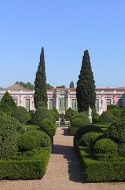 |
|
Queluz is very close to Lisbon and has one of the most wonderful palaces on the
area: the Queluz National Palace!
In 1747, the Infant D. Pedro (future D. Pedro III - King of Portugal),
commissioned the architect Mateus Vicente de Oliveira to transform his
17th-century hunting lodge into a Rococo summer palace. The main body of the
Palace, built until 1758, was finished after the marriage of D. Pedro with D.
Maria Francisca, future Queen D. Maria I (1760). By this time, the wealthy
saloons were ennobled, as well as the beautiful gardens with all sorts of
baroque fountains, tiles and statues. Jean Baptiste Robillion was the french
master in charge of the magnificent Robillion Pavilion, the gardens and the
redesign of the Music Room.
Frequently compared to the Versailles Palace, this monument - apart from the
pavilion built by Robillion with strong french European influences - is very
Portuguese both in its scale and artistic spirit.
Nowadays, this palace is used by the Portuguese State as a residence for
government and state chiefs that visit Portugal and for special meetings. It is
also open to visitors, so make sure you try one of the many tasty dishes
available at the Cozinha Velha restaurant located in one of the palace wings and
that you don't miss the chance to see the incredible decorative arts exhibition
coming from royal collections.
|
| | Palácio de Mafra |
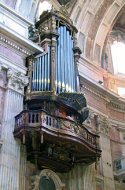 |
|
Work began on the massive palace and monastery at Mafra in 1717 after Joao V
vowed to build a monastery in gratitude for the birth of an heir. It was a
modest building at first, intended to house a small number of monks, but as more
ships arrived in Portugal bringing more wealth from the New World, more
extravagant plans were made. Altogether 52,000 men worked on the building which,
when finished, could cater for 330 friars, housed a royal place and one of
Europe’s finest libraries with some 40,000 volumes. Celebrations lasted for
eight days when the Basilica was consecrated on the Kings 41st birthday. Joao V
died in Lisbon on July 31 1750.
Successive monarchs treated the palace as a hunting lodge. When the family left
for exile in Brazil in 1807, they took the bulk of the furniture with them. As
troops assembled to stem Napoleon's invasion, Mafra became a military base and
the monastery a barracks.
Nowadays, this building ensemble is partially under IPPAR's rule which is
developing a recovery and improvement Programme, after a previous study carried
out between 1994 and 1997. A top priority has been the recovery of the
historical organs.
|
| | Palácio da Pena |
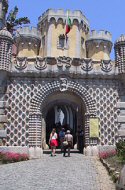 |
|
Palácio da Pena originated in 1839, when the king consort D. Fernando II
acquired the 'Our Lady of Pena Monastery' ruins to adapt it to a palace. The
original building, once occupied by the Jerónimos monks, dates from 1503. The
main facade of the convent was kept and so was the church and cloister, whose
galleries are covered with tiles placed there around 1520.
Being born in Germany, D. Fernando II brought to Portugal the romantic Germanic
architecture. The palace, a project of the Eschwege Baron, is inspired by
Bavaria’s palaces and brings together Moorish, Gothic and Manueline influences.
In the 90's, the palace faced significant restoration and the most important
alteration can be seen from afar: the yellow and pink exterior. Although it
shocked the inhabitants of Sintra, used to seeing it 'dressed' in grey, the
truth is that these were the original colours of Pena Palace!
The fourth most visited national monument in Portugal is furnished with pieces
of the period and the visitor can enjoy wonderful views of the surrounding areas
from the verandas.
|
| | Costa da Caparica |
 |
|
Costa da Caparica belongs to the Almada council, located on the south bank of
the river Tagus where magnificent sandy beaches stretch south for nearly 30
kilometres from Caparica to Cabo Espichel. Big areas of eucalyptus, pine-trees
and acacia-trees spread along the white, fine sands. But Costa da Caparica is
more than beaches and huge areas of white sands, although this is the first
thing you'll remember when you think of it.
Costa da Caparica also holds a market between Tuesdays and Sundays where
fishermens wives and farmers cry out their products There are exquisite fish
restaurants where you can taste fresh and unusual dishes and beach cafes with
all night animation.
On the cliff above the beach with its brightly-coloured sardine boats, stands an
old Capuchin Monastery originally founded in 1558.
During the summer months, you can hire a small tent on the beach to get some
shadow when the temperatures are too high or take a ride on an open-carriage
railway that runs for 10 km along the beaches of the Costa da Caparica.
|
| | Arrábida Mountains |
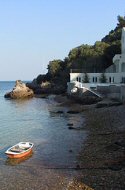 |
|
Close to Lisbon there are charming places that you will undoubtedly fall in love
with. The Arrábida Mountains is definitively one of them! Located between
Setúbal and the wonderful area of Sesimbra, the Arrábida boasts 35 km of
limestone mountains and a wonderful coastline.
It was declared a Natural Park in 1976 to protect the many species existent here
and some of the areas can only be visited with official authorisation. Walking
through these mountains is an unforgettable experience - dazzling views of the
coast and the contact with nature make this a place where you will want to
return to again and again.
Its coast has some of the best beaches in the region, for example Portinho da
Arrábida pictured on the right and the Galapos beaches where visitors can enjoy
the delights of sunshine and a true blue sea and try an excellent selection of
fresh fish and shellfish.
|
| | Expo Park |

|
|
This is a new up market area of Lisbon. The former grounds of the 'Expo 98' were
not left to abandonment and is now called 'Nations Park' (Parque das Nações).
Used both during the day and at night, it offers numerous attractions: you can
use it's promenade by the river for a run, for a walk or just to sit and enjoy
the view of Vasco da Gama Bridge; visit some of the pavilions that are still
open like the Oceanarium, the Virtual Reality Pavilion, the Knowledge Pavilion,
Macau Pavilion, attend live concerts in the Atlantic Pavilion; enjoy the cable
car ride; cross the street and go shopping in the Vasco da Gama Shopping Centre;
have an exquisite meal in some of the finest restaurants in town or just have a
drink in one of the relaxed bars! As you can see, there is a choice for
everyone.
The park was built with the general theme of "The oceans, a heritage for the
future" and some 142 countries and international organizations participated.
Today it offers a unique and exciting experience!
|
| | Oceanarium |
 |
|
Visitors will never cease to be amazed as they journey through Europe's largest
Oceanarium. Inhabited by 16.000 animals and plants representing over 450
different species, the Oceanarium offers visitors a unique and enchanting
experience.
Four biotypes, each recreating one of the world’s coastal habitats, are located
in the four corner towers which encircle the central aquarium. Together, they
constitute a representative set of ocean environments.
The Oceanarium is Europe’s largest aquarium. In the world, just one aquarium has
larger dimensions than our own - the Osaka Aquarium in Japan. It was built some
10 years ago by the same architect who designed the Lisbon Oceanarium – Peter
Chermayeff.
The Global Ocean tank, one of the world’s largest aquariums (4 million litres),
is visible throughout a visit to the Oceanarium.
The tank habitat is that of the high seas, and a good percentage of its
inhabitants are large animals, known for being strong swimmers. Most are
migratory species, and ranges can span several oceans. The best known are the
sharks, rays and barracudas. Large shoals of fish can also be found on the high
seas, although they are more common in coastal waters and on the continental
shelf.
|
| | Cascais |
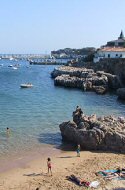 |
|
Traditionally a small fishing port, Cascais has changed during the last 100
years to become one of the favourite tourist destinations in Portugal. It exudes
a cosmopolitan atmosphere without losing its local flavour.
In Cascais, the bay is the main attraction. It is worthwhile walking around the
pathways that surrounds the bay taking note of the contrast between the vivid
colours of the small fishing boats and the sober ones of the yachts and sail
boats at the yacht club.
After admiring the bay you may wish to go to the fortress, to The Museum of the
Sea and on to the fascinating Museum of Conde Castro Guimarães, with its small
private beach. Here you can listen to some of the best classical concerts that
take place in Cascais.
If you take pleasure in walking in parks, there is one next to the museum where
you can relax beneath the shade its foliage provides during the hotter hours of
the day.
On your way back towards the bay you can walk through some of the typical narrow
streets of the town and see the traditional white houses, patterned pavements,
wrought iron and old tiled fronts.
Wondering through the centre of town is very pleasant and you will discover
charming houses, picturesque corners dotted with small cosy restaurants, cafes
and shops, where you can rest until you feel like going on again. In other parts
of the town you will find old palaces and luxurious villas with magnificent
architecture which is worthwhile examining in detail. The Forte de S. Jorge (St.
George Fort), re-opened in December 2000, was once one of the coasts most
important defensive structures and is now a military museum. The main facade was
rebuilt based on documents from 1796 and some divisions were used to portray
scenes on what would be a normal day in the fortress.
In order to get to know a town or city very well there is nothing better than
being driven by your imagination, allowing yourself the freedom to get lost
among its streets until you feel like finding your way again.
|
| | Sintra |
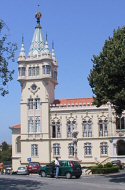 |
|
Sintra is a very, very romantic area near Lisbon. Refuge for the lonely and
enchanting scenery for lovers, make sure you see Sintra with your own eyes as
each person has a unique perspective of this marvellous area.
Home of the delicious Sintra cheese-cakes, this is a region with many charms.
Monuments, sea and mountains get together in one of the most perfect
combinations. Sintra's mountain ridge starts right on the heart of the 'Vila'
and ends into the Ocean, on the most western point of mainland Europe - Cabo da
Roca.
Declared a World Heritage site by UNESCO, Sintra was once home to the
aristocracy who chose it to build their palaces and mansion-houses. Before you
leave Sintra, make sure you visit the Royal Palace (Paço Real), the National
Palace of Pena (Palácio Nacional da Pena), the Moors Castle (castelo dos
Mouros), the Monserrate Palace and its gardens (Palácio de Monserrate) and some
of the museums, like the most singular Toy Museum (Museu do Brinquedo) that
displays a fascinating collection of toys.
Mysterious Sintra is unique not only because of its many monuments, nature and
beaches, but also due to its peculiar characteristic alleys. If you take a
stroll through these alleys you will almost be able to go back in time.
|

